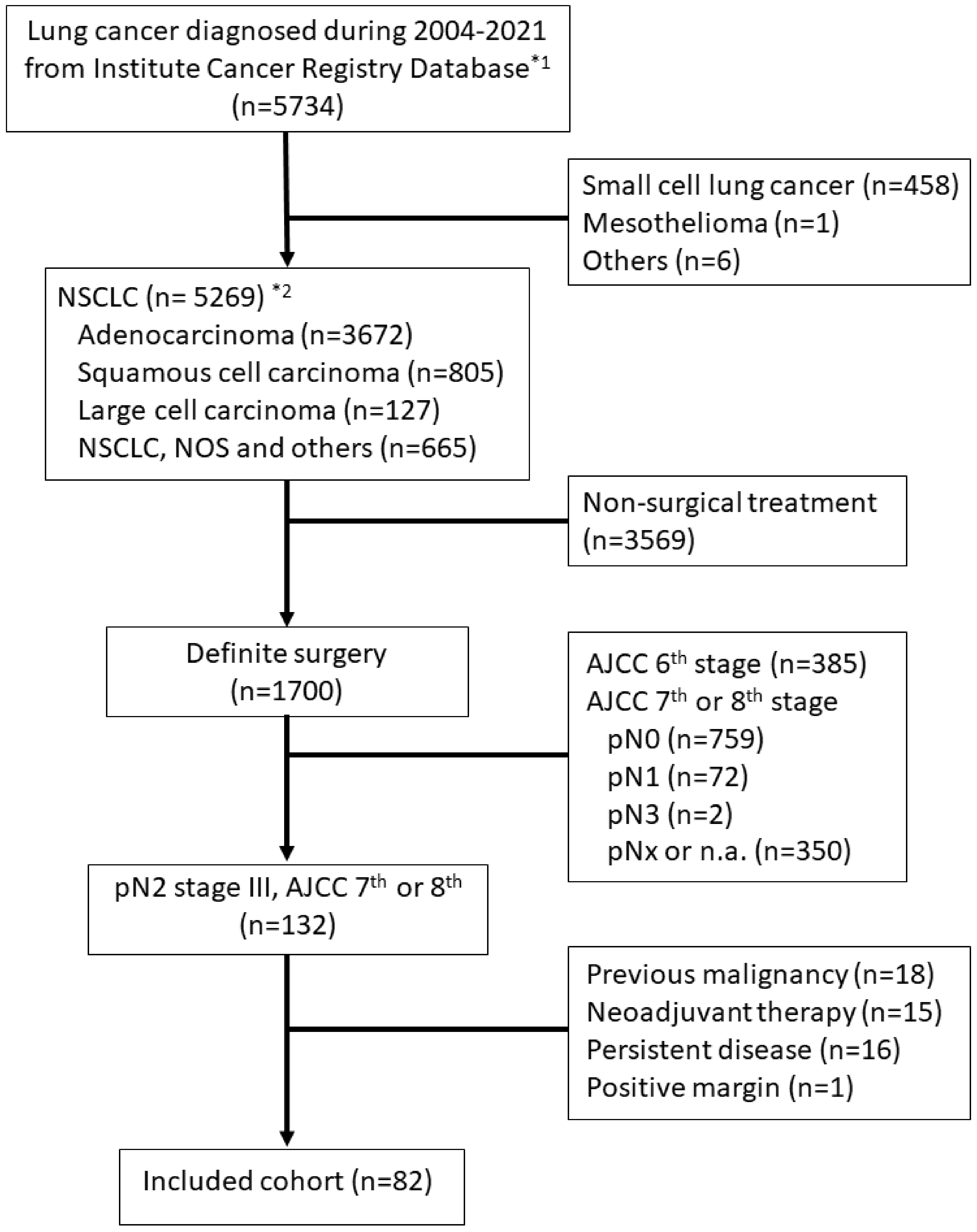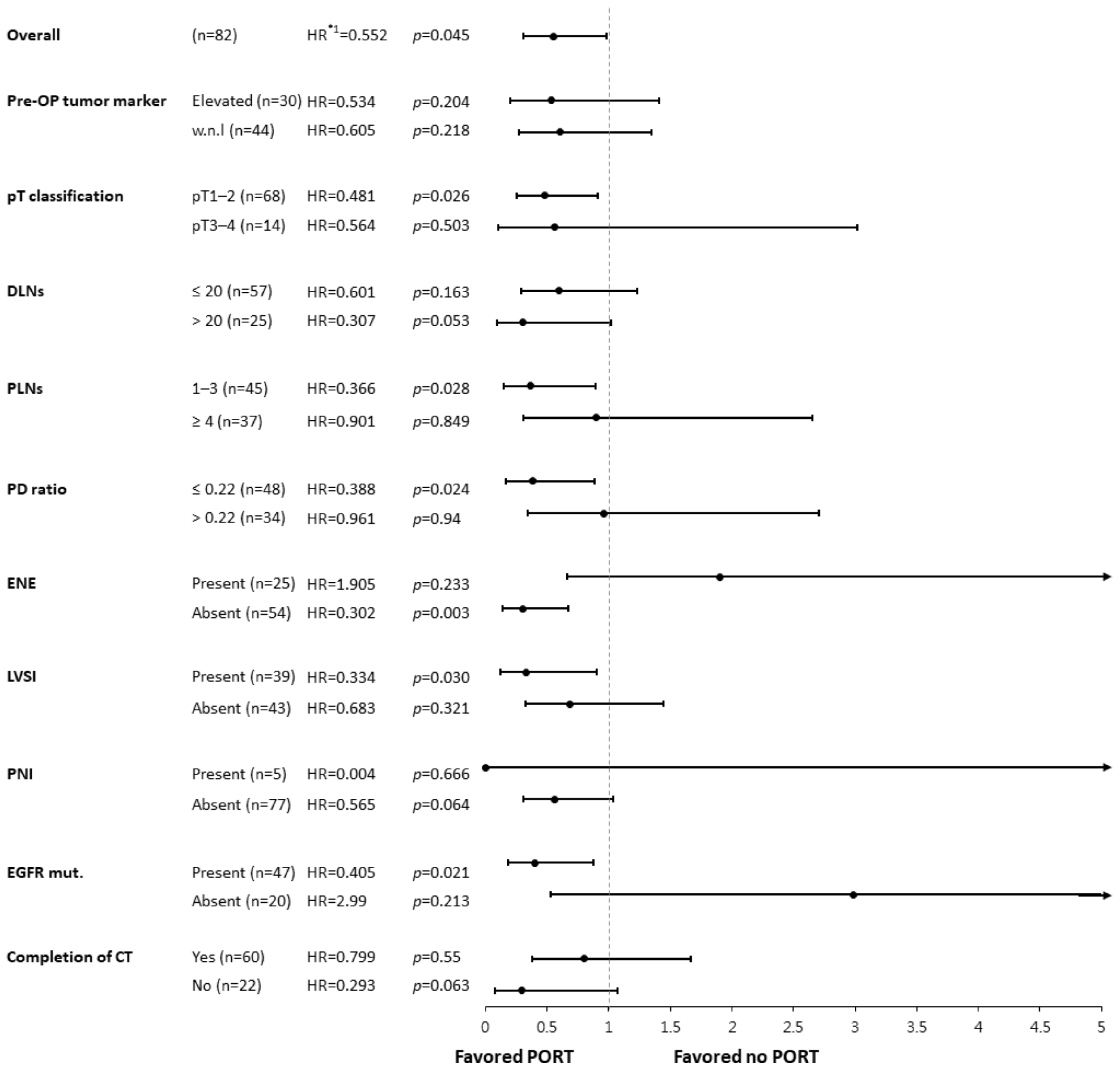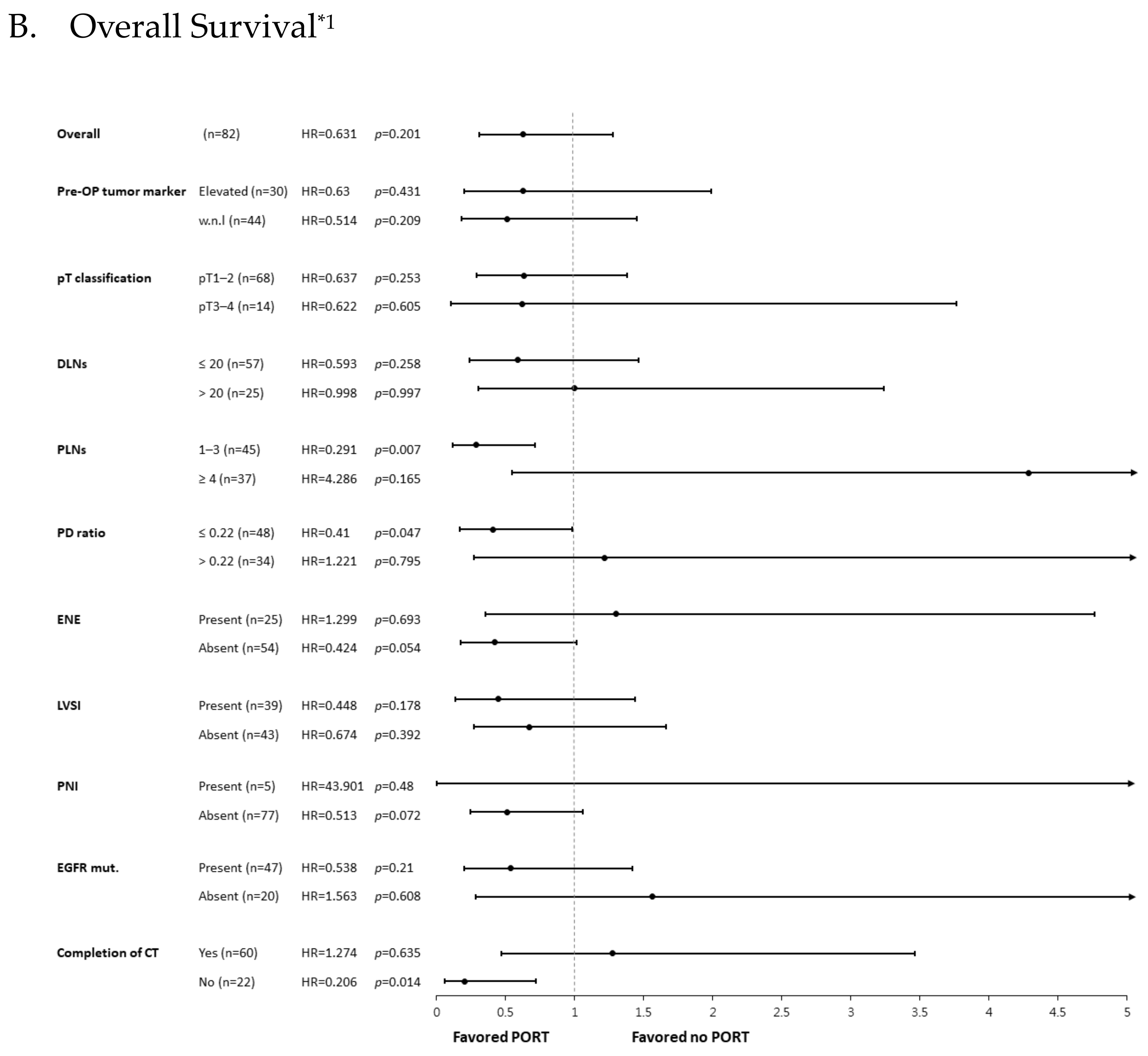Predictive Value of Clinicopathological Factors to Guide Post-Operative Radiotherapy in Completely Resected pN2-Stage III Non-Small Cell Lung Cancer
Abstract
:1. Introduction
2. Materials and Methods
2.1. Study Cohort and Data Collection
2.2. Definition of Endpoints
2.3. Statistical Analysis
3. Results
3.1. Treatment Outcomes and Prognostic Factors
3.2. Disease-Free Survival Benefit of PORT and Predicting Factors
3.3. Possible Survival Benefits from PORT in Subgroups
4. Discussion
5. Conclusions
Author Contributions
Funding
Institutional Review Board Statement
Informed Consent Statement
Data Availability Statement
Acknowledgments
Conflicts of Interest
Abbreviations
| NSCLC | non-small cell lung cancer |
| PORT | post-operative radiotherapy |
| EGFR mut. | epidermal growth factor receptor mutation |
| ENE | extranodal extension |
| PLNs | number of positive lymph nodes |
| DLNs | number of dissected lymph nodes |
| PD ratio | Positive-to-dissected lymph node ratio |
References
- Oliver, A.L. Lung Cancer: Epidemiology and Screening. Surg. Clin. N. Am. 2022, 102, 335–344. [Google Scholar] [CrossRef] [PubMed]
- Pignon, J.P.; Tribodet, H.; Scagliotti, G.V.; Douillard, J.Y.; Shepherd, F.A.; Stephens, R.J.; Dunant, A.; Torri, V.; Rosell, R.; Seymour, L.; et al. Lung adjuvant cisplatin evaluation: A pooled analysis by the LACE Collaborative Group. J. Clin. Oncol. 2008, 26, 3552–3559. [Google Scholar] [CrossRef] [PubMed]
- Wu, Y.L.; Tsuboi, M.; He, J.; John, T.; Grohe, C.; Majem, M.; Goldman, J.W.; Laktionov, K.; Kim, S.W.; Kato, T.; et al. Osimertinib in Resected EGFR-Mutated Non-Small-Cell Lung Cancer. N. Engl. J. Med. 2020, 383, 1711–1723. [Google Scholar] [CrossRef]
- Felip, E.; Altorki, N.; Zhou, C.; Csőszi, T.; Vynnychenko, I.; Goloborodko, O.; Luft, A.; Akopov, A.; Martinez-Marti, A.; Kenmotsu, H.; et al. Adjuvant atezolizumab after adjuvant chemotherapy in resected stage IB–IIIA non-small-cell lung cancer (IMpower010): A randomised, multicentre, open-label, phase 3 trial. Lancet 2021, 398, 1344–1357. [Google Scholar] [CrossRef]
- Burdett, S.; Rydzewska, L.; Tierney, J.; Fisher, D.; Parmar, M.K.; Arriagada, R.; Pignon, J.P.; Le Pechoux, C.; Group, P.M.-a.T. Postoperative radiotherapy for non-small cell lung cancer. Cochrane Database Syst. Rev. 2016, 10, CD002142. [Google Scholar] [CrossRef] [PubMed]
- Billiet, C.; Peeters, S.; Decaluwe, H.; Vansteenkiste, J.; Mebis, J.; Ruysscher, D. Postoperative radiotherapy for lung cancer: Is it worth the controversy? Cancer Treat. Rev. 2016, 51, 10–18. [Google Scholar] [CrossRef]
- Le Pechoux, C.; Pourel, N.; Barlesi, F.; Lerouge, D.; Antoni, D.; Lamezec, B.; Nestle, U.; Boisselier, P.; Dansin, E.; Paumier, A.; et al. Postoperative radiotherapy versus no postoperative radiotherapy in patients with completely resected non-small-cell lung cancer and proven mediastinal N2 involvement (Lung ART): An open-label, randomised, phase 3 trial. Lancet Oncol. 2022, 23, 104–114. [Google Scholar] [CrossRef]
- Hui, Z.; Men, Y.; Hu, C.; Kang, J.; Sun, X.; Bi, N.; Zhou, Z.; Liang, J.; Lv, J.; Feng, Q.; et al. Effect of Postoperative Radiotherapy for Patients With pIIIA-N2 Non-Small Cell Lung Cancer After Complete Resection and Adjuvant Chemotherapy: The Phase 3 PORT-C Randomized Clinical Trial. JAMA Oncol. 2021, 7, 1178–1185. [Google Scholar] [CrossRef]
- Zhou, W.; Christiani, D.C. East meets West: Ethnic differences in epidemiology and clinical behaviors of lung cancer between East Asians and Caucasians. Chin. J. Cancer 2011, 30, 287–292. [Google Scholar] [CrossRef]
- Levy, A.; Mercier, O.; Le Pechoux, C. Indications and Parameters Around Postoperative Radiation Therapy for Lung Cancer. J. Clin. Oncol. 2022, 40, 556–566. [Google Scholar] [CrossRef]
- Rami-Porta, R.; Wittekind, C.; Goldstraw, P. Complete Resection in Lung Cancer Surgery: From Definition to Validation and Beyond. J. Thorac. Oncol. 2020, 15, 1815–1818. [Google Scholar] [CrossRef] [PubMed]
- Eberhard, D.A.; Johnson, B.E.; Amler, L.C.; Goddard, A.D.; Heldens, S.L.; Herbst, R.S.; Ince, W.L.; Janne, P.A.; Januario, T.; Johnson, D.H.; et al. Mutations in the epidermal growth factor receptor and in KRAS are predictive and prognostic indicators in patients with non-small-cell lung cancer treated with chemotherapy alone and in combination with erlotinib. J. Clin. Oncol. 2005, 23, 5900–5909. [Google Scholar] [CrossRef] [PubMed]
- Bell, D.W.; Lynch, T.J.; Haserlat, S.M.; Harris, P.L.; Okimoto, R.A.; Brannigan, B.W.; Sgroi, D.C.; Muir, B.; Riemenschneider, M.J.; Iacona, R.B.; et al. Epidermal growth factor receptor mutations and gene amplification in non-small-cell lung cancer: Molecular analysis of the IDEAL/INTACT gefitinib trials. J. Clin. Oncol. 2005, 23, 8081–8092. [Google Scholar] [CrossRef] [PubMed]
- Melosky, B.; Kambartel, K.; Hantschel, M.; Bennetts, M.; Nickens, D.J.; Brinkmann, J.; Kayser, A.; Moran, M.; Cappuzzo, F. Worldwide Prevalence of Epidermal Growth Factor Receptor Mutations in Non-Small Cell Lung Cancer: A Meta-Analysis. Mol. Diagn. Ther. 2022, 26, 7–18. [Google Scholar] [CrossRef] [PubMed]
- Zhang, Y.L.; Yuan, J.Q.; Wang, K.F.; Fu, X.H.; Han, X.R.; Threapleton, D.; Yang, Z.Y.; Mao, C.; Tang, J.L. The prevalence of EGFR mutation in patients with non-small cell lung cancer: A systematic review and meta-analysis. Oncotarget 2016, 7, 78985–78993. [Google Scholar] [CrossRef] [PubMed]
- Deng, Q.; Wang, H.; Xiu, W.; Tian, X.; Gong, Y. Uncertain resection of highest mediastinal lymph node positive among pN2 non-small cell lung cancer patients: Survival analysis of postoperative radiotherapy and driver gene mutations. Jpn. J. Radiol. 2023, 41, 551–560. [Google Scholar] [CrossRef]
- Mardanshahi, A.; Gharibkandi, N.A.; Vaseghi, S.; Abedi, S.M.; Molavipordanjani, S. The PI3K/AKT/mTOR signaling pathway inhibitors enhance radiosensitivity in cancer cell lines. Mol. Biol. Rep. 2021, 48, 1–14. [Google Scholar] [CrossRef]
- Moretti, L.; Yu, D.S.; Chen, H.; Carbone, D.P.; Johnson, D.H.; Keedy, V.L.; Putnam, J.B., Jr.; Sandler, A.B.; Shyr, Y.; Lu, B. Prognostic factors for resected non-small cell lung cancer with pN2 status: Implications for use of postoperative radiotherapy. Oncologist 2009, 14, 1106–1115. [Google Scholar] [CrossRef]
- Liu, W.; Shao, Y.; Guan, B.; Hao, J.; Cheng, X.; Ji, K.; Wang, K. Extracapsular extension is a powerful prognostic factor in stage IIA-IIIA non-small cell lung cancer patients with completely resection. Int. J. Clin. Exp. Pathol. 2015, 8, 11268–11277. [Google Scholar]
- Sung, S.Y.; Kwak, Y.K.; Lee, S.W.; Jo, I.Y.; Park, J.K.; Kim, K.S.; Lee, K.Y.; Kim, Y.S. Lymphovascular Invasion Increases the Risk of Nodal and Distant Recurrence in Node-Negative Stage I-IIA Non-Small-Cell Lung Cancer. Oncology 2018, 95, 156–162. [Google Scholar] [CrossRef]
- Deng, W.; Xu, T.; Xu, Y.; Wang, Y.; Liu, X.; Zhao, Y.; Yang, P.; Liao, Z. Survival Patterns for Patients with Resected N2 Non-Small Cell Lung Cancer and Postoperative Radiotherapy: A Prognostic Scoring Model and Heat Map Approach. J. Thorac. Oncol. 2018, 13, 1968–1974. [Google Scholar] [CrossRef] [PubMed]
- Wu, K.; Peng, W.; Shuai, Z.; Peng, X.; Liu, H.; Zhang, S. The impact of postoperative radiotherapy on the survival of patients with stage III non-small cell lung cancer: A CONSORT-compliant analysis using the SEER database. Medicine 2023, 102, e34015. [Google Scholar] [CrossRef] [PubMed]
- Urban, D.; Bar, J.; Solomon, B.; Ball, D. Lymph node ratio may predict the benefit of postoperative radiotherapy in non-small-cell lung cancer. J. Thorac. Oncol. 2013, 8, 940–946. [Google Scholar] [CrossRef] [PubMed]
- Wang, S.; Ma, Z.; Yang, X.; Wang, Y.; Xu, Y.; Xia, W.; Chen, R.; Qiu, M.; Jiang, F.; Yin, R.; et al. Choice of postoperative radiation for stage IIIA pathologic N2 non-small cell lung cancer: Impact of metastatic lymph node number. Radiat. Oncol. 2017, 12, 207. [Google Scholar] [CrossRef] [PubMed]
- Lee, S.; Noh, O.K. Optimal positive lymph node ratio showing the benefit of postoperative radiotherapy in pathologic N2 non-small cell lung cancer: An exploratory study using the Surveillance, Epidemiology, and End Results data. Radiat. Oncol. J. 2022, 40, 37–44. [Google Scholar] [CrossRef] [PubMed]
- Yoo, C.; Yoon, S.; Lee, D.H.; Park, S.I.; Kim, D.K.; Kim, Y.H.; Kim, H.R.; Choi, S.H.; Kim, W.S.; Choi, C.M.; et al. Prognostic Significance of the Number of Metastatic pN2 Lymph Nodes in Stage IIIA-N2 Non-Small-Cell Lung Cancer After Curative Resection. Clin. Lung Cancer 2015, 16, e203–e212. [Google Scholar] [CrossRef] [PubMed]
- Yuan, C.; Tao, X.; Zheng, D.; Pan, Y.; Ye, T.; Hu, H.; Xiang, J.; Zhang, Y.; Chen, H.; Sun, Y. The lymph node status and histologic subtypes influenced the effect of postoperative radiotherapy on patients with N2 positive IIIA non-small cell lung cancer. J. Surg. Oncol. 2019, 119, 379–387. [Google Scholar] [CrossRef] [PubMed]
- Jin, J.; Xu, Y.; Hu, X.; Chen, M.; Fang, M.; Hang, Q.; Chen, M. Postoperative radiotherapy option based on mediastinal lymph node reclassification for patients with pN2 non-small-cell lung cancer. Curr. Oncol. 2020, 27, e283–e293. [Google Scholar] [CrossRef]




| Subgroup | n | Port | No Port | p *1 | |
|---|---|---|---|---|---|
| Overall | 82 | 73.2% | 26.8% | ||
| Age | ≤60 y/o | 41 | 75.6% | 24.4% | 0.618 |
| >60 y/o | 41 | 70.7% | 29.3% | ||
| Sex | Male | 34 | 70.6% | 29.4% | 0.657 |
| Female | 48 | 75.0% | 25.0% | ||
| Laterality | Right lung | 45 | 71.1% | 28.9% | 0.642 |
| Left lung | 37 | 75.7% | 24.3% | ||
| Pre-OP tumor marker *2 | Elevated | 30 | 66.7% | 33.3% | 0.459 |
| w.n.l. | 44 | 75% | 25% | ||
| n.a. | 8 | 87.5% | 12.5% | ||
| pT classification *3 | pT1–2 | 68 | 75% | 25% | 0.410 |
| pT3–4 | 14 | 64.3% | 35.7% | ||
| Histology | Adeno. | 73 | 71.2% | 28.8% | 0.327 |
| SCC | 4 | 75% | 25% | ||
| Others | 5 | 100% | 0% | ||
| Grade | Grade 2 | 50 | 70% | 30% | 0.418 |
| Grade 3 | 32 | 78.1% | 21.9% | ||
| DLNs | ≤20 | 57 | 75.4% | 24.6% | 0.484 |
| >20 | 25 | 68% | 32% | ||
| PLNs | 1–3 | 45 | 66.7% | 33.3% | 0.143 |
| ≥4 | 37 | 81.1% | 18.9% | ||
| PD ratio *4 | ≤0.22 | 48 | 68.8% | 31.2% | 0.283 |
| >0.22 | 34 | 79.4% | 20.6% | ||
| ENE | Present | 25 | 68.0% | 32.0% | 0.736 |
| Absent | 54 | 75.9% | 24.1% | ||
| n.a. | 3 | 66.7% | 33.3% | ||
| LVSI | Present | 39 | 82.1% | 17.9% | 0.084 |
| Absent | 43 | 65.1% | 34.9% | ||
| PNI | Present | 5 | 80% | 20% | 0.722 |
| Absent | 77 | 72.7% | 27.3% | ||
| EGFR mut. | Present | 47 | 68.1% | 31.9% | 0.525 |
| Absent | 20 | 80% | 20% | ||
| n.a. | 15 | 73.3% | 26.7% | ||
| Completion of CT *5 | Yes | 60 | 78.3% | 21.7% | 0.081 |
| No | 22 | 59.1% | 40.9% | ||
| Distant Metastasis | Disease-Free Survival | ||||||
|---|---|---|---|---|---|---|---|
| Univariate | Univariate | Multivariate *5 | |||||
| Factors | HR | p | HR | p *5 | HR | p | |
| Pre-OP tumor marker *1 | Elevated | 1.532 | 0.150 | 1.698 | 0.063 | 1.823 | 0.039 |
| pT classification *2 | pT3–4 | 0.526 | 0.140 | 0.643 | 0.250 | ||
| DLNs | >20 | 0.901 | 0.735 | 0.865 | 0.624 | ||
| PLNs | ≥4 | 1.574 | 0.102 | 1.359 | 0.251 | ||
| PD ratio *3 | ≤0.22 | 1.846 | 0.027 | 1.630 | 0.068 | 1.646 | 0.080 |
| ENE | + | 1.418 | 0.224 | 1.299 | 0.347 | ||
| LVSI | + | 1.361 | 0.272 | 1.269 | 0.386 | ||
| PNI | + | 1.484 | 0.452 | 1.803 | 0.261 | ||
| EGFR mut. | + | 1.058 | 0.862 | 1.157 | 0.650 | ||
| Completion of CT *4 | + | 0.695 | 0.227 | 0.736 | 0.292 | ||
| PORT | + | 0.697 | 0.221 | 0.541 | 0.030 | 0.552 | 0.045 |
Disclaimer/Publisher’s Note: The statements, opinions and data contained in all publications are solely those of the individual author(s) and contributor(s) and not of MDPI and/or the editor(s). MDPI and/or the editor(s) disclaim responsibility for any injury to people or property resulting from any ideas, methods, instructions or products referred to in the content. |
© 2023 by the authors. Licensee MDPI, Basel, Switzerland. This article is an open access article distributed under the terms and conditions of the Creative Commons Attribution (CC BY) license (https://creativecommons.org/licenses/by/4.0/).
Share and Cite
Chien, J.-C.; Hu, Y.-C.; Tsai, Y.-J.; Chien, Y.-T.; Feng, I.-J.; Shiue, Y.-L. Predictive Value of Clinicopathological Factors to Guide Post-Operative Radiotherapy in Completely Resected pN2-Stage III Non-Small Cell Lung Cancer. Diagnostics 2023, 13, 3095. https://doi.org/10.3390/diagnostics13193095
Chien J-C, Hu Y-C, Tsai Y-J, Chien Y-T, Feng I-J, Shiue Y-L. Predictive Value of Clinicopathological Factors to Guide Post-Operative Radiotherapy in Completely Resected pN2-Stage III Non-Small Cell Lung Cancer. Diagnostics. 2023; 13(19):3095. https://doi.org/10.3390/diagnostics13193095
Chicago/Turabian StyleChien, Ju-Chun, Yu-Chang Hu, Yi-Ju Tsai, Yu-Ting Chien, I-Jung Feng, and Yow-Ling Shiue. 2023. "Predictive Value of Clinicopathological Factors to Guide Post-Operative Radiotherapy in Completely Resected pN2-Stage III Non-Small Cell Lung Cancer" Diagnostics 13, no. 19: 3095. https://doi.org/10.3390/diagnostics13193095
APA StyleChien, J.-C., Hu, Y.-C., Tsai, Y.-J., Chien, Y.-T., Feng, I.-J., & Shiue, Y.-L. (2023). Predictive Value of Clinicopathological Factors to Guide Post-Operative Radiotherapy in Completely Resected pN2-Stage III Non-Small Cell Lung Cancer. Diagnostics, 13(19), 3095. https://doi.org/10.3390/diagnostics13193095






